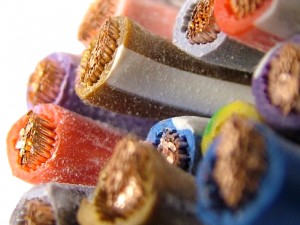The Key Elements: Core Shape, Size and Stranding
Core shape and size-related performance

A tube is the best shape for a conductor. This is because electricity travels best on the surface of a conductor and a tube has a large surface area (see ‘Skin Effect‘). The example shown here is a high frequency transmitter mast feed.
Stranding cores is a way to make a practical conductor with a lot of surface area; for example, the surface of the strands in a 1.8mm diameter wire made up of 800 strands add up to that of a 50mm tube.
Whether stranded cores are better than solid depends on the application:

- Fine stranded cores are good for high frequency transmission and are flexible but expensive.
- Thicker strands cost lest but are less flexible and not so good at high frequencies as the stronger current concentrations cause energy to dissipate as electro-magnetically induced vibrations.
- Solid core cable is stiff, but can be made very precisely and cheaply and is good for IDC termination.
Electrically, the larger the conductor gauge, the better. However, in low-level signal applications the gauge can have less of an effect on signal attenuation and accuracy than the dielectric. Wire gauge becomes more of a factor for signals on longer distance transmissions (e.g. several hundred metres).